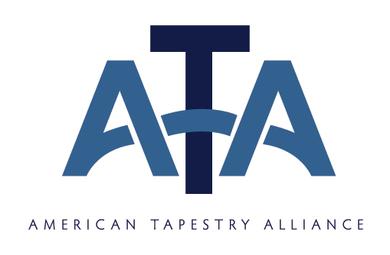
Laura Kamian McDermott
Judy’s Skylight, Todos Santos, 2011
8 in x 10 in

Laura Kamian McDermott
Casita, Shapes and Shadow, 2012
18 in x 22 in
Laura Kamian McDermott’s Artist Statement
I came to tapestry after a period of upheaval interrupted my art-making process and left me in a funk. I became desperate to make my way back to a consistent, everyday, familiar art practice and so began snapping low-quality photos of corners, ceilings, lights, and other parts of building interiors on my phone camera, which was always handy. I worked with the imagery in my sketchbook, further abstracting it, adding color and elements of fantasy into the ordinary snapshots of fluorescent light fixtures, ceiling fans, shower doors, and skylights. I had a new freedom to go about the most routine parts of my day with an eye for subject matter that I could embellish, exaggerate, and tweak. The result was a more livable universe. Soon it became clear that Tapestry, with its set boundaries and material warmth, was the means by which this sparse yet welcoming architectural imagery wanted to be expressed.
Tapestry works well for expressing a 2D picture plane in a textile that cannot help but be sculptural in the end. I like that juxtaposition- flat yet sculptural. In this series, I have made use of the double-weft interlock and pointed dovetailing techniques to get bold outlines on my shapes, while building a structurally sound tapestry. Color is of the utmost importance to me, so I hand-dye my yarns to be sure to have access to the colors I see in my mind’s eye.

Laura Kamian McDermott
My Old Kitchen, 2011
22 in x 22 in
Laura Kamian McDermott’s Biography
After painting my way through high school and college, I took up knitting in the late nineties. Soon I was trying to find a way to marry my fine art and fiber art practices. I played around with combinations of materials from both worlds, and in 2004 my primary medium became fiber-based installations. In 2009, I injured my back while installing a large-scale version of my knitted “Sampler Series” at the Mills Building in SF. With the injury came an upheaval of my art-making process, and a lot of time spent flat on my back in yoga class. I started snapping low-res pictures of ceilings at this time with my phone, playing with the imagery in my sketchbook. Soon it became clear that the images wanted to become tapestries, with the shapes building architecturally, line by line. I have been working in tapestry ever since. “Judy’s Skylight, Todos Santos” and “Casita Shapes and Shadows” came out of this architectural abstraction series. I’ve also woven a number of pieces in my “Mystery Key Skyline” series, taken from stencils of keys that I have laying around that I no longer know what they unlock, but am too superstitious or sentimental to throw away.
The ATA artist pages were a huge help for locating materials and equipment as a beginning tapestry weaver. I use Henry’s Attic 2-ply Crown Colony for weft (thanks to Mary Zicafoose and her page!), and either wool or cotton seine twine for warp. I dye my own weft yarns with Dharma and Jacquard Acid Dyes because I need to be able to weave the colors I see in my mind’s eye. The Dharma Trading website has charts on which of the colors are the most lightfast, and I stay in that range. My first loom was a Loom-in-a-Tube, which I love and is always warped with a project in process- such a useable little loom, and travels well! I also have a couple of Shannock looms, and my husband just built me a copper loom from Archie Brennan’s design for my birthday.
